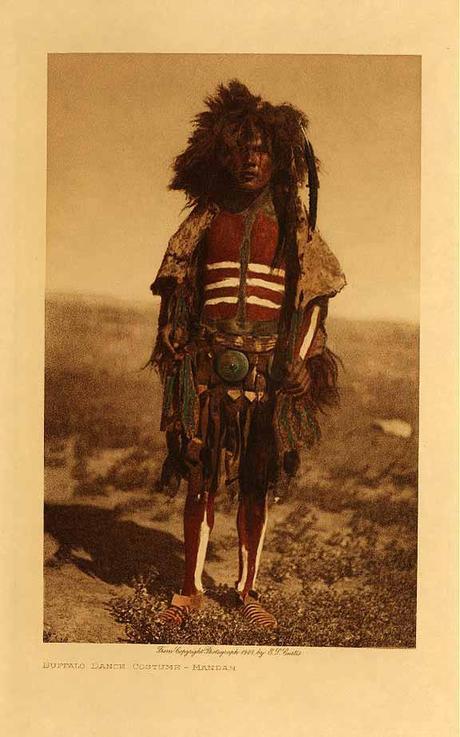At this time of year I like to take a break from heavy scholarly reading for lighter fare, which means I can be forgiven for having just consumed Stephen Ambrose’s Undaunted Courage: Meriwether Lewis, Thomas Jefferson, and the Opening of the American West (1997). Because Lewis & Clark were among the first travelers to record what they saw and learned about Native Americans during their epic 1804-06 journey, I was hoping for some ethnohistoric nuggets that would tide me over until I tackle the 7-volume Moulton edition of the Lewis & Clark journals. While it was a good summer read, the nuggets were few and far between. I’ll be reading the journals sooner rather than later.
There was, however, one item of note. During the winter of 1804-05, Lewis & Clark camped with the Mandans on the Upper Missouri in today’s North Dakota. The Mandans lived in earthen lodges and were typical eastern plains horticulturalists who planted and hunted. In 1805, the still plentiful buffalo ranged within reasonable distances of the Mandan villages, so each year in early January they held a 3-day long dance designed to bring the buffalo near and ensure hunting success. It was aptly known as the Buffalo Dance and was immortalized 30 years later by the artist-ethnographer George Catlin:
 The pageantry of this dance also caught the attention of photographer-ethnographer Edward S. Curtis, who shot this image (which happily adorns my modest collection) of a Mandan buffalo dancer some 70 years after Catlin painted:
The pageantry of this dance also caught the attention of photographer-ethnographer Edward S. Curtis, who shot this image (which happily adorns my modest collection) of a Mandan buffalo dancer some 70 years after Catlin painted:
 With all this ethnographic attention, it’s not surprising that the Mandan Buffalo Dance is well known and the subject of a school lesson plan which instructs teachers to read this to their students:
With all this ethnographic attention, it’s not surprising that the Mandan Buffalo Dance is well known and the subject of a school lesson plan which instructs teachers to read this to their students:
Catlin emphasizes that the threat of starvation motivates the Mandans to perform the Buffalo Dance, which holds great social and religious significance. Its purpose is to call upon the Great Spirit to summon buffalo. The dance never fails because the Mandans repeat the motions and music until the herd comes.
This is a good summary of the dance, albeit heavily sanitized. What students aren’t told is that during each night of the dance, young married couples would entreat Mandan elders to have sex with the wife. Here is how Ambrose describes the scene:
The dance began. To the music of rattles and drums, the old men of the village, dressed in their finery, entered the lodge, gathered into a circle, sat down, and waited. Soon the young men and their wives filed in, to take their places at the back of the circle. They fixed pipes for the old men, and a smoking ceremony ensued.
As the drumbeat became more insistent and the chanting swelled, one of the youngsters would approach and beg him to take his wife, who in her turn would appear naked before the elder. She would lead him by the hand and — but let Clark tell it, as only he can: “the Girl then takes the Old man (who verry often can Screcely walk) and leades him to a Convenient place for the business, after which they return to the lodge.”
In the event that the old man failed to gratify the wife, the husband would offer her again and again, and throw a robe into the bargain, and beg the old man not to despise the couple.
“All this,” Clark noted, “is to cause the buffalow to Come near So that They may kill them.”
All this business for buffalo had a serious purpose, beyond the possibility that the young were simply giving thanks to elders for their many years of service to the village.
The idea was that the elders had been successful hunters and hunting power could be transmitted sexually. In the absence of same sex attraction, this required the elders to intercourse with young wives, who in turn transmitted the power to their husbands in the conjugal bed.
Fortunately for the men of the Lewis & Clark expedition, anyone — not just elder Mandan men — could possess transferable hunting power. Because most of the men were accomplished hunters, they were “untiringly zealous in attracting the cow” and transmitting power. Unfortunately for all involved, not only power was transmitted — venereal disease was widespread.
Apocryphal legend has it that within a few days the buffalo approached and the hunt was good. Such is the power of sexual hunting magic.


